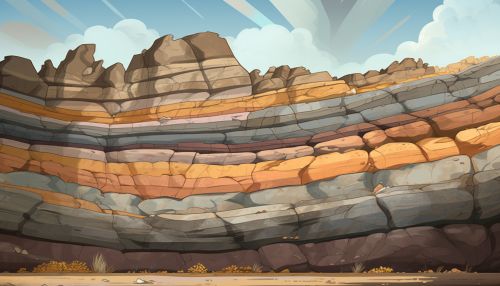Taxon Range Biozone
Introduction
A Taxon Range Biozone, also known as a Range Zone, is a type of biostratigraphic unit that is defined by the total stratigraphic range of a particular taxon. In other words, it represents the time interval from the first appearance to the last appearance of a particular species or group of species in the geologic record. This concept is a fundamental tool in the field of paleontology and is widely used in the correlation of stratigraphic sequences.


Definition and Characteristics
The concept of a Taxon Range Biozone was first introduced by A.W. Grabau in 1940. It is defined as the body of strata representing the known stratigraphic and geographic range of occurrence of any selected element or elements in the rock record. The selected elements can be a single species, a group of species, or even a whole taxon.
A Taxon Range Biozone is characterized by the presence of a particular taxon, which can be identified by its distinctive morphological features. The boundaries of a Taxon Range Biozone are defined by the first appearance datum (FAD) and the last appearance datum (LAD) of the defining taxon. The FAD is the point in the stratigraphic record where a taxon first appears, while the LAD is the point where it last appears.
Importance in Biostratigraphy
Taxon Range Biozones are an essential tool in biostratigraphy, a branch of geology that uses the distribution of fossils in sedimentary rocks to establish relative ages and correlate rocks from different locations. By identifying the presence of specific taxa in a stratigraphic sequence, geologists can establish a relative chronology and correlate it with sequences in other regions.
One of the main advantages of using Taxon Range Biozones is their simplicity. They are relatively easy to identify and do not require detailed knowledge of the evolutionary history of the taxa involved. This makes them particularly useful in the early stages of biostratigraphic studies, where the main goal is to establish a basic framework for correlation.
Limitations and Challenges
Despite their usefulness, Taxon Range Biozones also have some limitations. One of the main challenges is the Signor-Lipps effect, a phenomenon named after P.W. Signor and J.H. Lipps. This effect refers to the fact that the fossil record is incomplete, and the true first and last appearances of a taxon are likely to be underrepresented. This can lead to errors in the determination of the boundaries of a Taxon Range Biozone.
Another challenge is the Lazarus effect, which refers to the apparent disappearance and reappearance of taxa in the fossil record. This can be caused by various factors, such as changes in sedimentation rates, taphonomic biases, or sampling biases. These factors can complicate the identification and correlation of Taxon Range Biozones.
Examples
There are numerous examples of Taxon Range Biozones in the geologic record. One of the most well-known is the Ammonite biozones of the Jurassic and Cretaceous periods. These biozones are defined by the stratigraphic ranges of various ammonite species and have been used to correlate rocks across vast geographic areas.
Another example is the Graptolite biozones of the Ordovician and Silurian periods. These biozones are based on the stratigraphic ranges of different graptolite species, which are excellent index fossils due to their rapid evolution and wide distribution.
